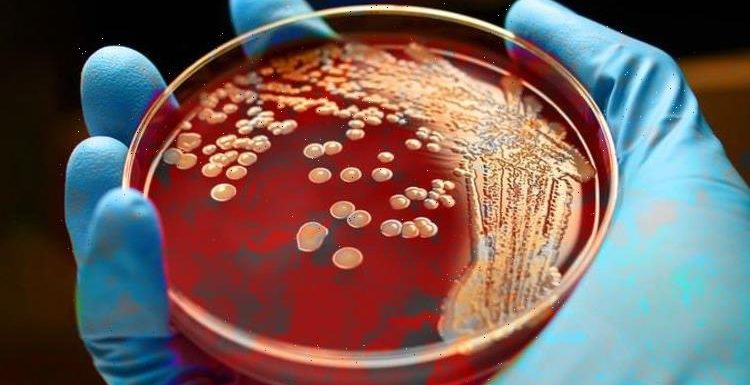
MRSA: Doctor explains symptoms of the superbug
We use your sign-up to provide content in ways you’ve consented to and to improve our understanding of you. This may include adverts from us and 3rd parties based on our understanding. You can unsubscribe at any time. More info
The revolutionary new treatment, which utilises the powers of genetic engineering, could be deployed on patients within two years. A team of researchers in Spain modified a Mycoplasma pneumoniae bacteria to remove its ability to cause harm and redirected it to attack other dangerous bugs instead. The “living medicine” has so far only been tested on lab mice but the results have been promising.
The modified bacteria were shown to destroy biofilms – clusters of bacteria attached to a surface – of drug-resistant bacteria.
Biofilms have proven particularly resistant to immune systems and medicines, and can even stay dormant for long periods of time before striking.
Studies have shown bacteria clustered in biofilms are 10 to 100 times more antibiotic-resistant than their free-flowing counterparts.
MRSA is the most common type of biofilm-associated bacteria.


But a breakthrough could be just around the corner thanks to the Spanish researchers.
Dr Maria Lluch, a biotechnologist at the Centre for Genomic Regulation (CRG) in Barcelona and the study’s leader, said: “Our technology has been designed to meet all safety and efficacy standards for application in the lung, with respiratory diseases being one of the first targets.”
According to the expert, the researchers will next look to address the high-scale production and manufacturing of their new drug.
They also expect to start clinical trials by 2023.
Man in wheelchair from MRSA learns to WALK again
The MRSA superbug (methicillin-resistant Staphylococcus aureus) is resistant to a number of widely available antibiotics, making it incredibly hard to treat.
According to the NHS, approximately one in 30 people carry the bacteria on their skin, usually in the nose, armpits, groin or buttocks.
The MRSA colonies are typically harmless but can be transmitted through contact with skin or contaminated surfaces, like towels and bedsheets.
Hospital patients are particularly susceptible to contracting the superbug as they frequently come in contact with multiple people and open wounds, feeding tubes, IV drips and catheters act as pathways to infection.


Underlying health conditions and weakened immunities also make their bodies less able to fight off the bacteria.
When the MRSA bacteria gets deeper into the skin, it can cause swelling, pain, pus, fever, chills and even dizziness and confusion.
The Spanish trials have successfully removed the drug-resistant bacteria on medical implants.
The drug was injected under the skin of mice and treated infection in 82 percent of the animals.
Their modified Mycoplasma pneumoniae targets MRSA biofilms by releasing molecules that fight infection, without being targetted by the body’s immune system.
Study co-author Professor Luis Serrano said: “One of the great benefits of the technology is once they reach their destination, bacterial vectors offer continuous and localised production of the therapeutic molecule.
“Like any vehicle, our bacteria can be modified with different payloads that target different diseases, with potentially more applications in the future.”
The study’s findings were published in the journal Molecular Systems Biology.
Source: Read Full Article